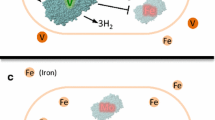Abstract
Attempts to grow the yeast Candida utilis in continuous culture, using media in which all the potassium had been replaced by other monovalent cations, revealed that neither lithium, sodium, caesium nor ammonium ions could functionally substitute for potassium. However, potassium could be effectively replaced by rubidium which gave (on a molar basis, and under conditions where cation availability limited growth) the same yield of cells as did potassium.
Comparison of potassium- and rubidium-limited cultures showed them to be virtually identical in all the measured parameters, with the single exception of the maximum growth rate value which was considerably decreased in the rubidium-containing culture (0.35 h-1 as compared with 0.55 h-1).
When, with variously-limited chemostat cultures, both potassium and rubidium were supplied in equimolar amounts, these ions were taken up by the cells in a ratio that varied with both the growth rate and the nature of the growth limitation. With glucose-, phosphate- or magnesium-limited cultures, the molar ratio K+:Rb+ was 1:0.6 (at D=0.1 h-1) and 1:0.17 (at D=0.5 h-1). In contrast, ammonia-limited cultures took up increased amounts of rubidium when growing at a low rate such that the ratio was 1:1.2, at D=0.1 h-1, though still 1:0.17 at the higher growth rate value (D=0.5 h-1).
From a comparison of glucose- and ammonialimited cultures growing first with an equimolar mixture of potassium and rubidium, and then with rubidium alone, it was noted that the yield on oxygen was significantly decreased when potassium was absent.
These results are discussed in relation to the transport and possible functions of monovalent cations in micro-organisms. It was concluded that, on the basis of these experiments, some objections could be raised against estimation of potassium transport rates by means of the tracer 86Rb.
Similar content being viewed by others
References
Aiking, H., Tempest, D. W.: Growth and physiology of Candida utilis NCYC 321 in potassium-limited chemostat culture. Arch. Microbiol. 108, 117–124 (1976)
Aiking, H., Sterkenburg, A., Tempest, D. W.: Influence of specific growth limitation and dilution rate on the phosphorylation efficiency and cytochrome content of mitochondria of Candida utilis NCYC 321. Arch. Microbiol. 113, 65–72 (1977a)
Aiking, H., Sterkenburg, A., Tempest, D. W.: The occurrence of polyphosphates in Candida utilis NCYC 321, grown in chemostat cultures under conditions of potassium-and glucose-limitation. FEMS Microbiology Letters 1, 251–254 (1977b)
Eddy, A. A., Hinshelwood, C.: The utilization of potassium by Bacterium lactis aerogenes. Proc. roy. Soc. B 136, 544–562 (1950)
Herbert, D., Phipps, P. J., Tempest, D. W.: The chemostat: Design and instrumentation. Lab. Pract. 14, 1150–1161 (1965)
Lasnitzki, A., Szörényi, E.: The influence of alkali cations on the fermentation capacity of yeast. Biochem. J. 29, 580–587 (1935)
Lester, G.: Requirement for potassium by bacteria. J. Bacteriol. 75, 426–428 (1958)
MacLeod, R. A., Snell, E. E.: The effect of related ions on the potassium requirement of lactic acid bacteria. J. biol. Chem. 176, 39–57 (1948)
Perry, J. J., Evans, J. B.: Role of potassium in the oxidative metabolism of Micrococcus sodonensis. J. Bacteriol. 82, 551–555 (1961)
Slayman, C. W., Tatum, E. L.: Potassium transport in Neurospora. 3. Isolation of a transport mutant. Biochim. biophys. Acta (Amst.) 109, 184–193 (1965)
Tempest, D. W.: Quantitative relationships between inorganic cations and anionic polymers in growing bacteria. Symp. Soc. gen. Microbiol. 19, 87–111 (1969)
Tempest, D. W., Herbert, D.: Effect of dilution rate and growthlimiting substance on the metabolic activity of Torula utilis cultures. J. gen. Microbiol. 41, 143–150 (1965)
Wyatt, H. V.: The effect of alkali metals on the growth of Staphylococcus pyogenes. Exp. cell. Res. 30, 56–61 (1963)
Author information
Authors and Affiliations
Rights and permissions
About this article
Cite this article
Aiking, H., Tempest, D.W. Rubidium as a probe for function and transport of potassium in the yeast Candida utilis NCYC 321, grown in chemostat culture. Arch. Microbiol. 115, 215–221 (1977). https://doi.org/10.1007/BF00406377
Received:
Issue Date:
DOI: https://doi.org/10.1007/BF00406377




